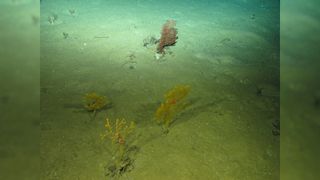The deep seafloor is filled with entire branches of life yet to be discovered
Nearly two-thirds of seafloor life has not been discovered yet.

The deep-ocean floor is teeming with undiscovered life-forms that help to regulate Earth's climate, a new study finds.
Researchers sequenced DNA from deep-sea sediments around the world and found that there is at least three times more life on the seafloor than there is higher up in the ocean. What's more, nearly two-thirds of that life has not been formally identified yet.
"It's been known since the 1960s that species diversity is very high in the deep sea, so very high numbers of species," co-author Andrew Gooday, a deep-sea biologist and emeritus fellow at the National Oceanography Centre in England, told Live Science. "What was new about this study was that there was a lot of novel diversity at the higher taxonomic level."
In other words, there are a lot of unknown evolutionary lineages — like whole families of species — waiting to be discovered.
Related: Photos: Gorgeous landscapes hidden beneath polar seas
The deep-ocean floor covers more than half of Earth's surface but is home to some of the least-studied ecosystems, according to the study. Previous research analyzed DNA collected through the water column, from above the ocean floor up to the surface, so this latest study sought to complete the picture and give a global view of biodiversity in the ocean by looking at seafloor DNA within deep-sea sediments.
The research team sequenced DNA from 418 seafloor samples gathered from all the major oceanic basins between 2010 and 2016 and compared them with existing DNA data from the rest of the ocean, separating the known DNA of dead organisms that had sunk to the bottom from the DNA of organisms native to the seafloor.
Sign up for the Live Science daily newsletter now
Get the world’s most fascinating discoveries delivered straight to your inbox.
Rather than trying to identify individual species from the DNA, the team looked at what they called sequence variants, or different versions of DNA sequences, to discriminate between major groups of species, like families or orders.
Most of the seafloor DNA could not be assigned to a known group on the tree of life, meaning it belonged to undiscovered family, order or other taxonomic group. The team focused on eukaryotic DNA from small organisms. "We're talking about small animals less than a millimeter [0.04 inches] in size, and probably a lot of protozoans, a lot of single-celled organisms," Gooday said.
Larger animals, such as octopuses, weren't sequenced, so the richness of deep-sea life is likely even greater than what the team found. Gooday noted that they also looked only at DNA contained within sediments and not rocky outcrops or other deep-sea niches where other organisms may be living.
Why does the seafloor contain so much life?
It's not altogether surprising that so much biodiversity lies deep beneath the ocean's surface. The seafloor is a more complex environment than the ocean above it, with microhabitats like deep coral reefs and underwater volcanoes for species to adapt to. "If you have a very uniform environment, then all species are exposed to the same habitat," Gooday said. "But if that habitat is divided into lots of microhabitats, then species can specialize."
The researchers also learned more about the role the deep ocean plays in the so-called biological pump, the process by which ocean organisms such as phytoplankton absorb carbon from the atmosphere near the surface and sink to the deep sea, where the carbon is sequestered in the sediments. The team could predict the strength of the pump based on the composition of DNA in the sediments, so the researchers now know some plankton communities play a greater role than others in absorbing carbon dioxide and regulating the climate.
The findings were published Feb. 4 in the journal Science Advances.
Originally published on Live Science.

Patrick Pester is a freelance writer and previously a staff writer at Live Science. His background is in wildlife conservation and he has worked with endangered species around the world. Patrick holds a master's degree in international journalism from Cardiff University in the U.K.
Most Popular

